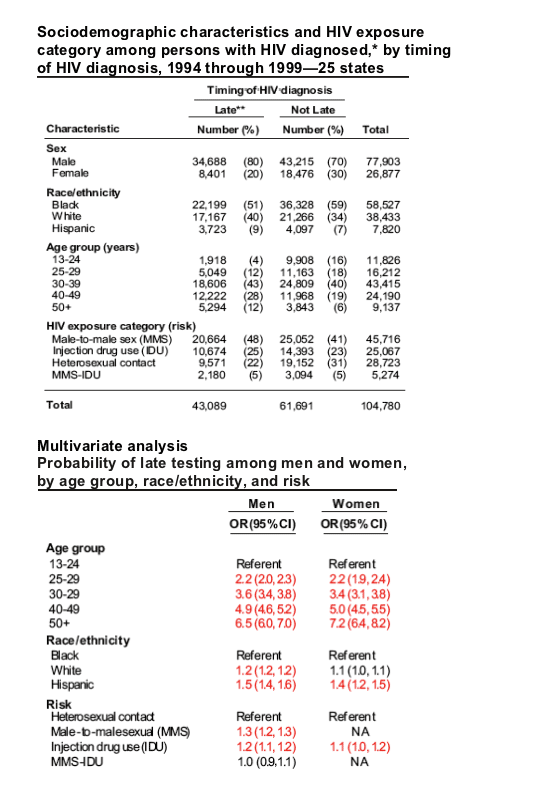| |
Late AIDS Diagnosis 1994-99
|
| |
| |
Reported by Jules Levin
"Frequency and Predictors of Late HIV Diagnosis in the United States, 1994 through 1999"
CROI 2002, Seattle, WA
J J Neal and PL Fleming
Centers for Disease Control and Prevention, Atlanta, Georgia
Analysis was restricted to cases among whites, blacks, and Hispanics, and to cases attributed to the four most commonly reported HIV exposure categories (risk): heterosexual contact, male-to-male sexual (MMS) contact, injection drug use (IDU), and MMS-IDU.
HIV diagnosis was defined as late if an AIDS diagnosis was made within one year of the first reported HIV diagnosis.
Results
From 1994 through 1999, an estimated 104,780 persons had HIV diagnosed.
Among these persons, an estimated 43,089 (41%) had HIV diagnosed late (i.e., within one year of AIDS diagnosis).
By year of diagnosis, percent late was relatively stable.
Percent late ranged from 16% among persons aged 13-24 years to 58% among persons aged 50 years and older.
Percent late was greater for-
-- Men (45%) compared with women (31%);
-- Hispanics (48%) and whites (45%) compared with blacks (38%);
-- Persons with HIV attributed to male-to-male sex (45%), injection drug use (43%), and male-to-male sex and injection drug use (41%) compared with
persons with heterosexually acquired HIV (33%).
ABSTRACT
Background: The first step of CDC's Serostatus Approach to Fighting the Epidemic (SAFE) is diagnosis of HIV infection in all infected individuals. Subsequent steps include linking HIV infected persons to care and prevention services, and supporting them in adhering to prescribed treatment and in adopting and sustaining HIV risk reduction behavior. Success of this approach will depend on timeliness of HIV diagnosis. Our objective was to describe frequency and predictors of late HIV diagnosis.
Methods: We analyzed national HIV/AIDS surveillance data from 25 states that have conducted integrated HIV/AIDS surveillance since 1994. HIV diagnosis was considered "late" if an AIDS diagnosis was made within one year of HIV diagnosis. Data reported to CDC through June 2001 were adjusted for delays in reporting; mode of HIV exposure for cases initially reported without
information on risk was statistically redistributed. We analyzed cases diagnosed from 1994 through December 1999 among persons aged 13 years and older by age group, sex, race/ethnicity, and HIV exposure mode. Summary Mantel-Haenszel odds ratios (OR ) were calculated for stratified analyses. MH
Results:
Among all HIV diagnoses, percentage late (41) remained relatively stable during 1994 through 1999. Percentage late increased with age and ranged from 11 for persons aged 13-19 years to 58 for persons 50 years and older; was greater for men (46) than women (33); greater for whites (46) and Hispanics (49)
compared with blacks (40); and greater for persons whose HIV exposure mode was male-to-male sexual contact (MMS) (46) or injection drug use (IDU) (44) compared with persons whose HIV exposure mode was heterosexual contact (HC) (35).
After
adjusting for age, probability of late diagnosis was greater for men than women (OR =1.5); greater for whites (OR =1.3) and MH MH Hispanics (OR =1.5) compared with blacks; and greater for MH persons exposed through MMS (OR =1.6) and IDU (OR =1.2) MH MH compared with persons exposed through HC.
Conclusions: A substantial proportion of persons living with HIV received their diagnosis late-within the same year AIDS was diagnosed. After controlling for age, substantial differences in probability of late diagnosis by sex, race/ethnicity, and HIV exposure mode were still observed. To improve timeliness of HIV diagnosis, reasons for persistent delays in testing and potential interventions to increase testing among recently infected persons need to be identified.

Summary
A substantial proportion (41%) of HIV-infected persons received their diagnosis late in the course of infection-within the same year AIDS was diagnosed.
Percent of diagnoses that were late increased with age.
Univariate analysis showed significant differences in age-adjusted probability of late diagnosis by sex, race/ethnicity, and risk.
Some of these differences were attenuated in the multivariate analysis. Relationships of age group, race/ethnicity, and risk were examined by fitting a model that included terms to assess possible interaction among the three covariates. The model showed significant interaction between-
--Age, race/ethnicity, and risk for men;
--Risk and race/ethnicity for women.
The final model, stratified by sex and race/ethnicity, showed that risk was not a strong predictor for late testing, but was strongest among black men and black
women.
Limitations
Because data were from only 25 states, these findings may not be nationally generalizable.
The data are not representative of all confidential HIV diagnoses, especially by race/ethnicity. Analysis was restricted to cases among whites, blacks, and Hispanics because the number of cases in other racial/ethnic groups was too small for meaningful analysis.
HIV-infected persons who tested anonymously were not reported to surveillance and not included in the analyses. If such persons had HIV diagnosed anonymously more than a year before AIDS, but delayed entry to care, they may contribute to an overestimate of late diagnosis.
The strength of age group as a predictor for late diagnosis may be due to selection bias. We may have selected for late diagnosis among older persons infected during the peak of the epidemic in the mid-1980s2 who delayed testing. For young persons infected more recently, most late HIV diagnoses would be among those whose infection progressed rapidly to AIDS.
Conclusions
A substantial proportion of HIV-infected persons received their diagnosis late in the course of infection-within the same year AIDS was diagnosed.
Frequency of late diagnosis varied by age, sex, race/ethnicity, and risk; race/ethnicity and risk appeared to be closely interrelated and may be acting as surrogates for other factors associated with late diagnosis.
Increasing awareness of serostatus and improving linkage to care and prevention services will require consideration of complex behavioral and cultural factors and
implementation of multiple strategies.
|
|
| |
| |
|
|
|